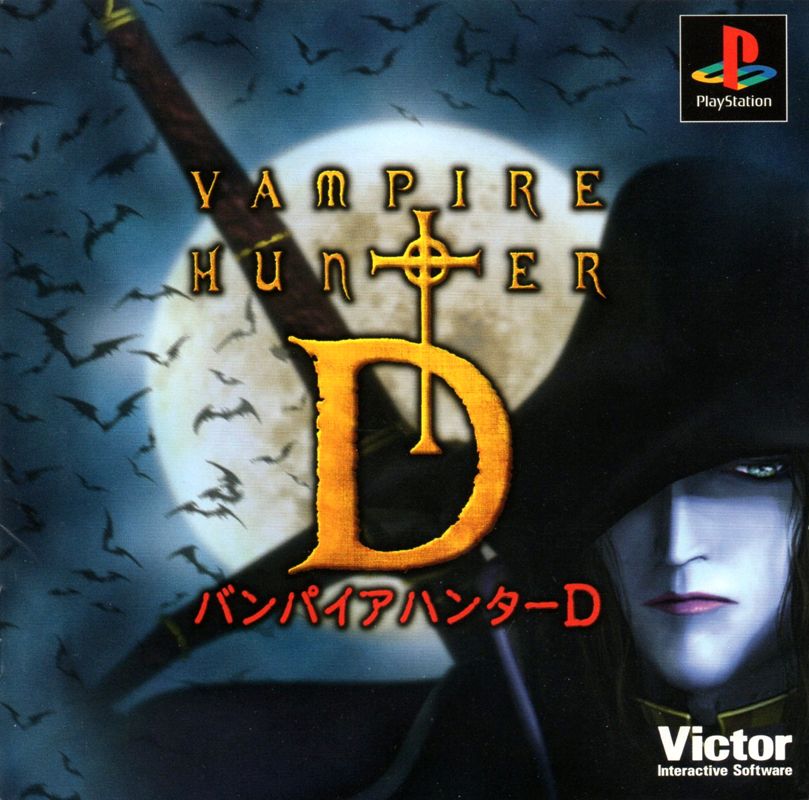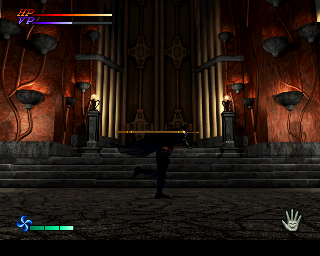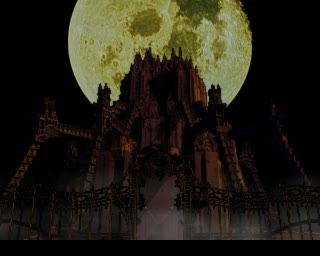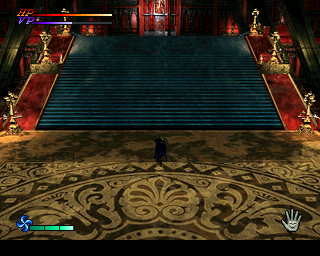Retro Replay Review
Gameplay
The core gameplay of Vampire Hunter D blends atmospheric exploration with tense combat encounters. Much like the early Resident Evil titles, the game uses pre-rendered backgrounds to craft claustrophobic castle corridors and sprawling chambers. Players guide D through Castle Chaith, solving environmental puzzles to unlock doors, activate mechanisms, and uncover secret passages. This puzzle element provides a welcome break from the relentless vampire hordes that lurk in every shadow.
(HEY YOU!! We hope you enjoy! We try not to run ads. So basically, this is a very expensive hobby running this site. Please consider joining us for updates, forums, and more. Network w/ us to make some cash or friends while retro gaming, and you can win some free retro games for posting. Okay, carry on 👍)
Combat is a satisfying blend of swordplay and supernatural abilities. D’s signature long sword delivers swift, powerful slashes, while his vampire powers—ranging from healing to offensive dark magic—offer strategic depth. Players must choose between conserving MP for special moves or relying on conventional melee strikes. Enemies vary from standard ghoul minions to more formidable ghouls with projectile attacks, forcing you to adapt your tactics on the fly.
One notable feature is the dual threat of the Marcus Brothers, rival vampire hunters who appear at key moments. They not only compete for the bounty but also introduce dynamic encounters that can catch you off-guard. Their unpredictable interventions heighten tension, as you never know if a familiar hallway will erupt into a three-way battle. This mechanic adds replay value, encouraging multiple playthroughs to see how these rivalries play out under different conditions.
Graphics
Vampire Hunter D’s graphics remain impressive, especially considering its roots in the late ’90s. The pre-rendered environments are richly detailed, featuring gothic architecture, eerie lighting effects, and macabre set pieces like dripping blood fountains and cobweb-laden corridors. These backgrounds provide a cinematic stage for D’s movements, making every new room feel like a carefully composed horror diorama.
Character models and animations hold up surprisingly well, with smooth motions for sword slashes, spellcasting gestures, and enemy transformations. D moves with a fluid grace that reinforces his half-vampire heritage, while the creatures you face range from shambling undead to sleek, predatory monstrosities. Occasional texture pop-ins and vertex clipping may surface on older hardware, but they rarely detract from the overall immersion.
The lighting and particle effects elevate key moments, such as when D unleashes his Bloodlust power or when torches flare across dim hallways. Shadows are used effectively to conceal traps and foes, prompting players to advance with caution. The soundtrack further enhances the visual presentation, with ominous strings and choral chants that sync seamlessly with the game’s haunting palette.
Story
Vampire Hunter D draws its narrative from the anime Vampire Hunter D: Bloodlust and the novel Vampire Hunter D: Demon Deathchase by Hideyuki Kikuchi. Set in a post-apocalyptic future where vampires rule over the remnants of humanity, the game captures the bleak, feudal atmosphere of D’s world. You assume the role of the stoic dhampir, D, hired to rescue a noblewoman abducted by a powerful vampire lord in Castle Chaith.
The plot unfolds through a combination of in-game dialogue, cinematic cutscenes, and environmental storytelling. Encounters with the Marcus Brothers provide memorable character moments and moral ambiguity, as you witness rival hunters who are every bit as ruthless as the vampires they pursue. These interactions deepen the narrative, painting D not only as a solitary warrior but as part of a larger web of bounty seekers and dark conspiracies.
While the story follows familiar vampire-hunter tropes, it distinguishes itself with mature themes of class struggle, existential horror, and the cost of vengeance. The revelation of the hidden evil within Castle Chaith adds a supernatural twist that keeps the pace brisk. In the end, the narrative pays off with a dramatic confrontation against the vampire lord and a haunting finale that leaves you questioning D’s relentless quest.
Overall Experience
Vampire Hunter D delivers a compelling blend of horror, action, and puzzle-based exploration. Its deliberate pacing allows tension to build between combat encounters, while the castle’s design rewards careful observation and backtracking. Veteran players of survival horror will appreciate the strategic resource management and the way the game encourages thoughtful decision-making over button-mashing.
The audiovisual presentation remains a highlight, with richly detailed backgrounds, atmospheric lighting, and a chilling soundtrack that underscores every step. Despite some dated technical quirks, the game’s art direction and animation quality still impress. Fans of dark fantasy and gothic horror will find themselves immersed in the world of post-apocalyptic nobility and supernatural intrigue.
Ultimately, Vampire Hunter D is a must-play for those who enjoy narrative-driven horror experiences with a strong emphasis on exploration and combat depth. The inclusion of rival hunters, layered puzzles, and a story rooted in beloved source material ensures that the game stands out among its peers. Whether you’re a longtime aficionado of the anime and novels or a newcomer curious about this iconic franchise, Vampire Hunter D offers a memorable journey into a world where humanity’s last hope wields a sword and ancient blood powers.
 Retro Replay Retro Replay gaming reviews, news, emulation, geek stuff and more!
Retro Replay Retro Replay gaming reviews, news, emulation, geek stuff and more!







Reviews
There are no reviews yet.